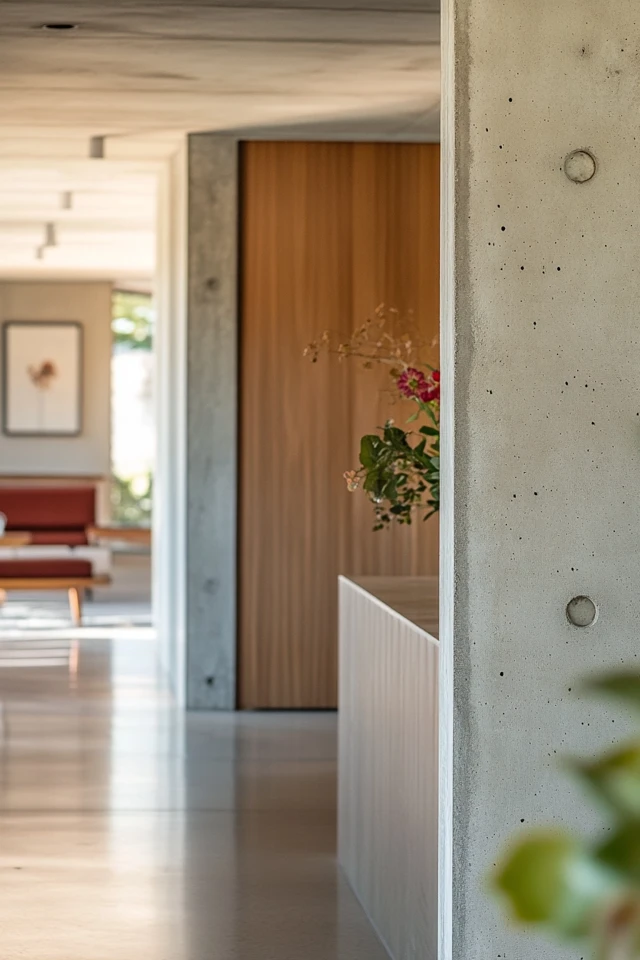Introduction
Concrete might seem like an unexpected material for creating a warm and stylish home, but in mid-century modern design, it’s a showstopper. This durable and versatile material brings an industrial edge that complements the clean lines, natural elements, and functional focus of mid-century interiors. Whether used for flooring, furniture, or decorative accents, concrete adds a timeless sophistication to your home.
I’ll admit, I used to think of concrete as too cold and utilitarian for residential interiors—until I designed a mid-century modern-inspired dining room with a polished concrete table. The result was breathtaking! The raw beauty of the concrete paired beautifully with walnut dining chairs and a geometric pendant light, creating a space that felt sleek yet inviting. From that moment on, I was hooked.
In this post, I’ll show you how to use concrete in your mid-century modern home to achieve a perfect balance of style, warmth, and durability. From statement walls to minimalist furniture, here are 10 creative ways to embrace this iconic material.
Why Concrete Works in Mid-Century Modern Homes
1. Timeless Appeal
Concrete’s clean, minimalist aesthetic aligns perfectly with mid-century modern design’s emphasis on simplicity and functionality.
2. Versatility
Concrete can take on many forms—polished, raw, dyed, or molded—making it a highly adaptable material for interiors.
3. Natural Connection
As a natural material, concrete pairs beautifully with wood, stone, and greenery, enhancing the organic feel of mid-century modern homes.
4. Durability
Concrete is incredibly long-lasting, making it a practical choice for high-traffic areas and outdoor spaces.
10 Ways to Use Concrete in Mid-Century Modern Homes
1. Polished Concrete Floors
Polished concrete floors are a hallmark of mid-century modern homes.
- Why It Works: The smooth, reflective surface adds a sleek, contemporary touch while maintaining durability.
- Styling Tips: Pair with a bold area rug or furniture in natural wood tones to add warmth and texture.
- Maintenance: Use a concrete sealer to protect the surface and keep it looking pristine.
2. Concrete Accent Walls
A concrete wall creates a dramatic focal point that instantly elevates a space.
- Where to Use: Try it in living rooms, dining areas, or behind a fireplace.
- Styling Tips: Pair with colorful abstract art, brass lighting, or a gallery wall to soften the industrial vibe.
- DIY Option: Use concrete-look wallpaper or panels for an easier installation.
3. Concrete Countertops
Concrete countertops add a modern edge to mid-century-inspired kitchens and bathrooms.
- Why It Works: Their clean, minimalist look complements mid-century cabinetry and fixtures.
- Styling Tips: Pair with warm wood cabinets, brass hardware, and vintage-inspired lighting.
- Customizable: Concrete can be tinted or textured for a personalized touch.
4. Concrete Fireplaces
A concrete fireplace is a striking addition to any mid-century modern home.
- Why It Works: Its raw, natural finish adds texture and depth to a room.
- Styling Tips: Surround it with low-profile furniture and accentuate it with floor-to-ceiling windows.
- Add Warmth: Use wood storage or a mantle to create a cozy contrast.
5. Concrete Furniture
Concrete isn’t just for structural elements—it makes stunning furniture, too.
- Ideas: Look for concrete coffee tables, side tables, or benches with minimalist designs.
- Styling Tips: Pair with soft textiles like wool throws or velvet cushions to balance the hardness.
- Outdoor Use: Concrete dining sets or benches are ideal for patios and courtyards.
6. Concrete Planters
Concrete planters are a simple way to bring mid-century modern style to your home.
- Why It Works: Their sleek, sculptural forms pair perfectly with the greenery of houseplants.
- Styling Tips: Use them to showcase large plants like fiddle leaf figs, monstera, or snake plants.
- DIY Option: Create your own planters using molds and quick-set concrete.
7. Concrete Kitchen Islands
A concrete kitchen island is both functional and eye-catching.
- Why It Works: Its durable surface makes it ideal for cooking and entertaining.
- Styling Tips: Pair with mid-century barstools in leather or wood for a retro-modern vibe.
- Customization: Add built-in features like a sink or storage for added functionality.
8. Concrete Outdoor Spaces
Concrete is a classic choice for outdoor mid-century design.
- Ideas: Use it for patios, walkways, fire pits, or outdoor seating areas.
- Styling Tips: Pair with teak or metal outdoor furniture and accentuate with string lights or potted plants.
- Durability: Seal the concrete to protect it from the elements and maintain its appearance.
9. Concrete Staircases
Concrete staircases are a bold design element that exudes mid-century modern sophistication.
- Why It Works: Their sculptural quality makes them both functional and artistic.
- Styling Tips: Add a sleek metal railing or wood treads for contrast.
- Versatility: Use floating concrete steps for a truly minimalist look.
10. Decorative Concrete Accessories
Concrete doesn’t have to dominate your space—it can be used for small, stylish accents.
- Ideas: Try concrete candle holders, bowls, trays, or bookends.
- Styling Tips: Combine with other natural materials like wood or ceramic for a layered look.
- Affordable: These accessories are budget-friendly and perfect for experimenting with concrete in your decor.
Picture Gallery
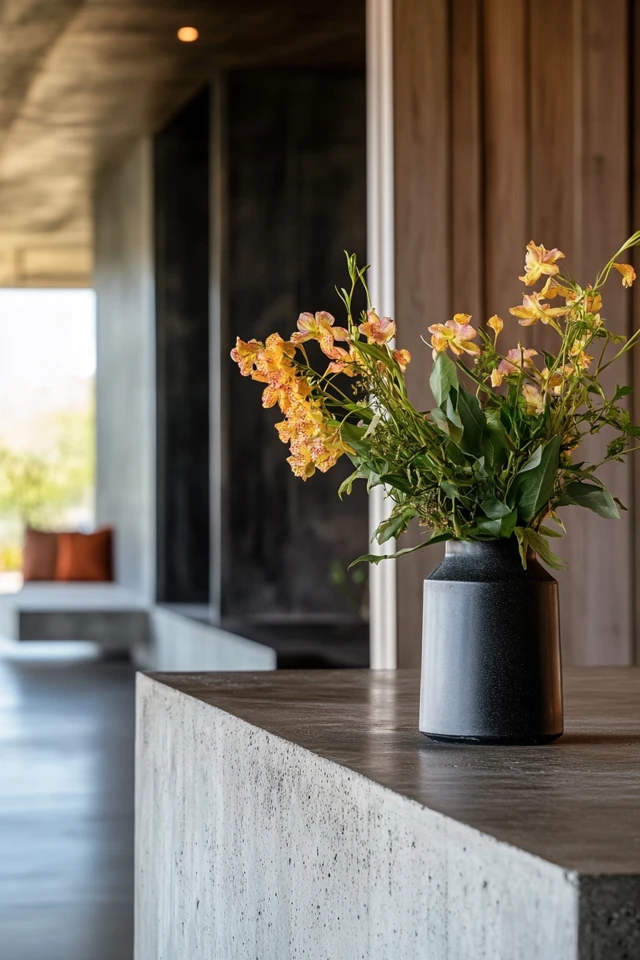
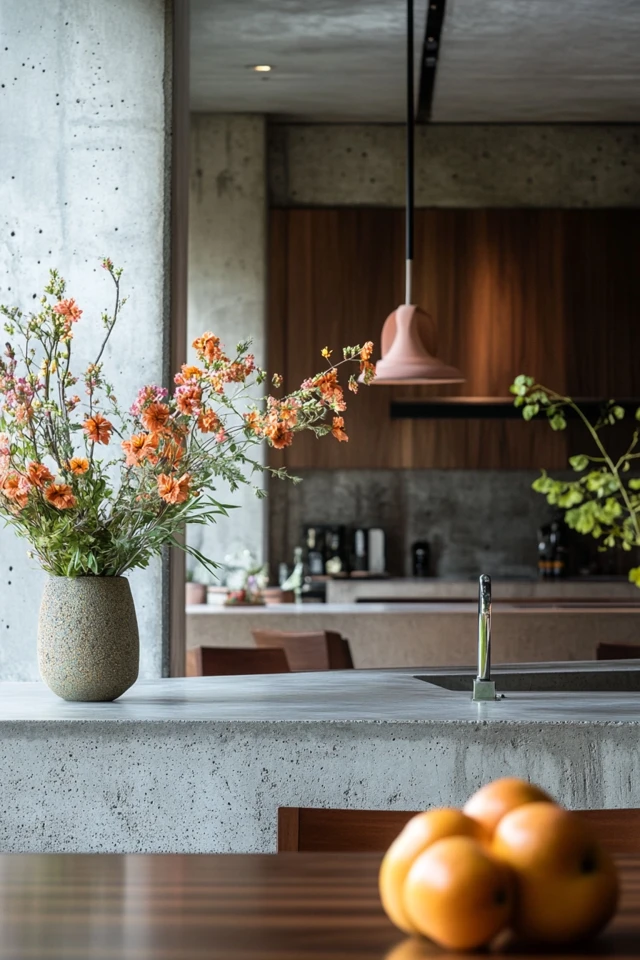
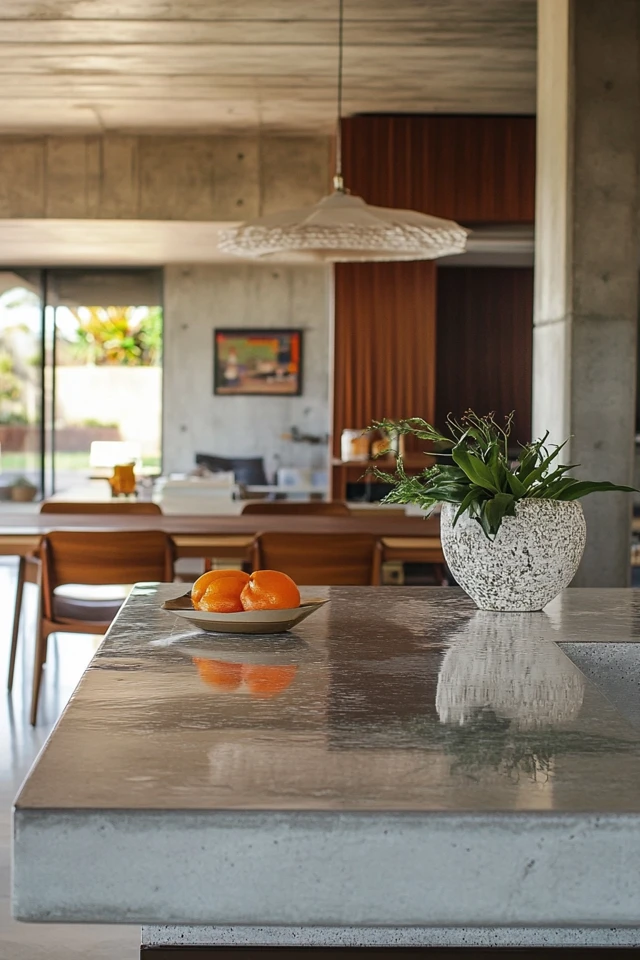

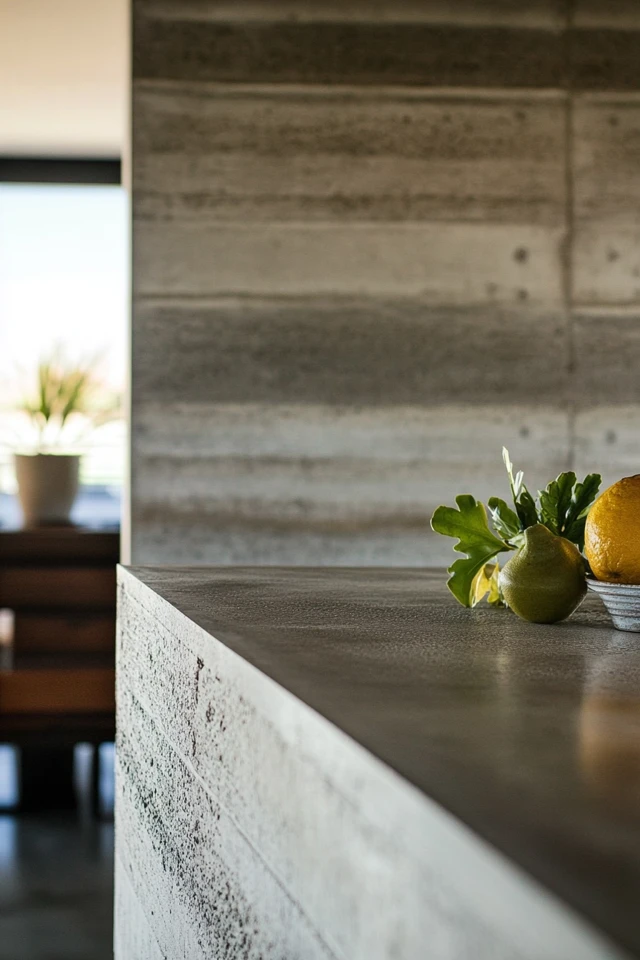
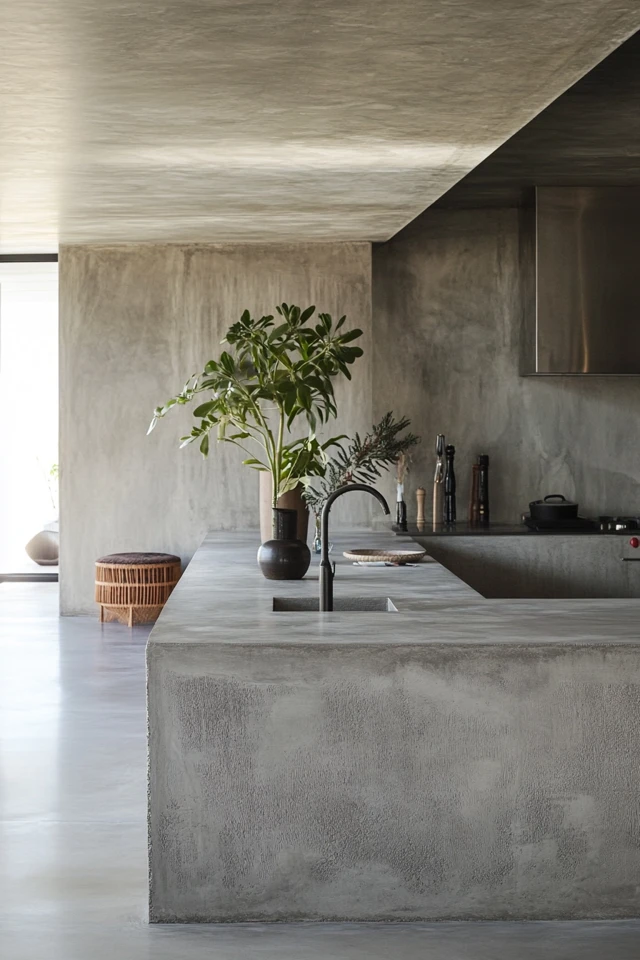
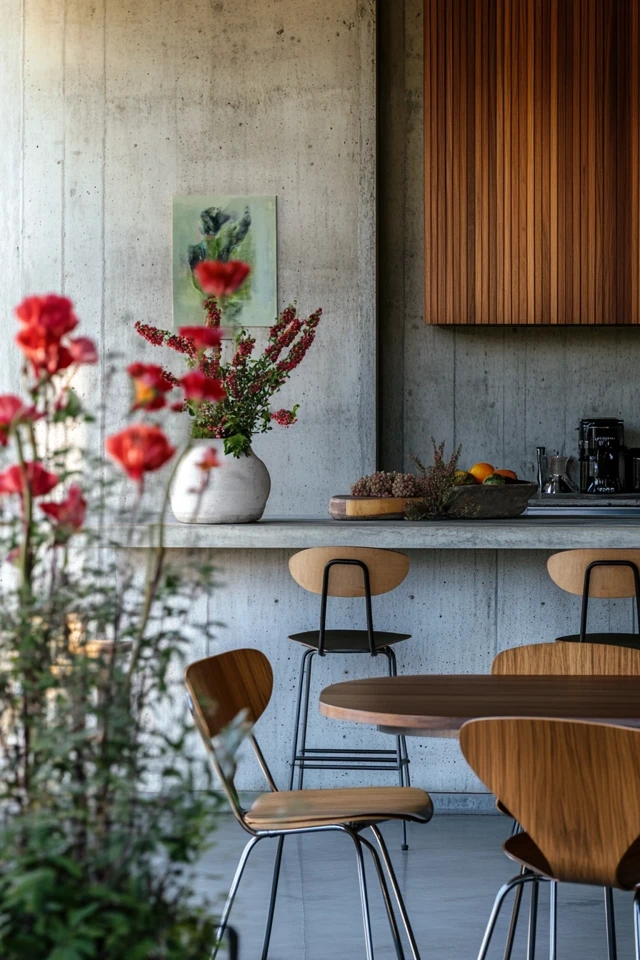
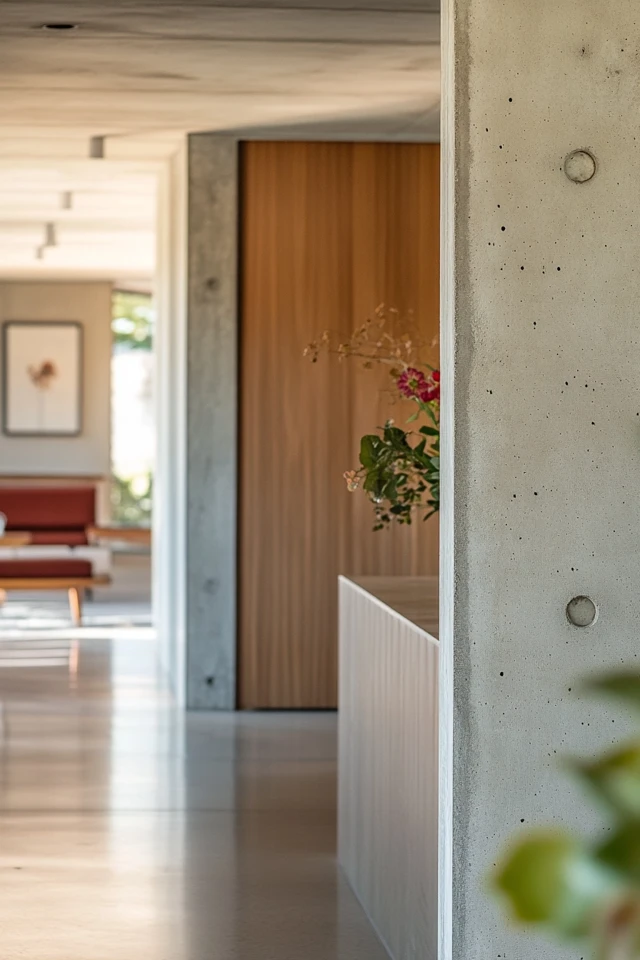
Tips for Working with Concrete
1. Balance with Warm Materials
Pair concrete with warm wood tones, textiles, and soft lighting to prevent the space from feeling cold.
2. Add Color Strategically
Use pops of color in furniture, rugs, or artwork to contrast with concrete’s neutral gray tone.
3. Layer Textures
Combine concrete with other textures like wool, leather, and glass to add depth and interest.
4. Consider Maintenance
Seal concrete surfaces to protect them from stains, moisture, and wear. For furniture and decor, choose pre-treated options for low maintenance.
Conclusion
Concrete is a game-changer in mid-century modern design. Its versatility, durability, and timeless appeal make it a material worth exploring for everything from flooring to furniture. By pairing it with warm elements, bold colors, and natural textures, you can create a home that feels both sophisticated and inviting.
Whether you’re adding a concrete planter to your living room or installing a polished concrete floor throughout your home, this material offers endless possibilities to elevate your space. I’ve seen firsthand how concrete can transform a room into a work of art, and I know it can do the same for you.
So, go ahead—embrace concrete in your mid-century modern home. You might be surprised by how effortlessly it blends beauty and functionality.
FAQ
Is concrete too cold for indoor spaces?
Not at all! Concrete can feel warm and inviting when paired with natural materials like wood, leather, and textiles.
How do I maintain concrete surfaces?
Seal concrete surfaces to protect against stains and moisture. Clean regularly with mild soap and water.
Can I DIY concrete decor?
Yes! Concrete is easy to work with and can be molded into planters, bowls, or even small furniture pieces using quick-set concrete.
Is concrete expensive to install?
While concrete can be cost-effective for certain applications like floors or countertops, custom designs and finishes may increase costs.
What colors work well with concrete in mid-century modern homes?
Earthy tones like mustard, rust, and olive green pair beautifully with concrete’s neutral gray. Add pops of color with teal, orange, or navy for a retro vibe.

